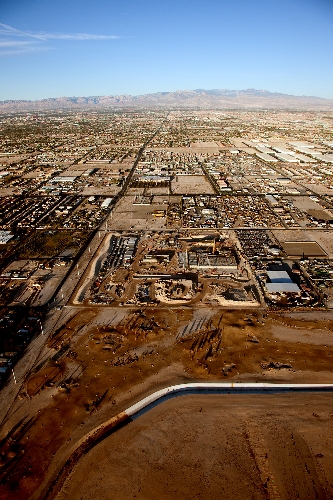North Las Vegas flow has no place to go
Construction is progressing on the new $240 million wastewater treatment facility in North Las Vegas, a project that began last year at Carey Avenue, south of Nellis Air Force Base.
But some officials have lately been wondering how the city's treated sewage will get out of town.
"You can't have a water reclamation facility and not be able to discharge," Councilman Richard Cherchio said.
North Las Vegas long planned to eventually discharge about 25 million gallons of effluent a day via an $860 million regional pipeline, which would have carried treated wastewater from each of the valley's sewage plants to a spot at the bottom of Lake Mead.
The regional Clean Water Coalition recently put the pipeline project on hold.
Now the city wants to release its effluent into the open, county-owned Sloan Channel, from which it would flow several miles into the Las Vegas Wash, then downstream to Lake Mead.
But the city must first secure a long-term agreement with Clark County to use the concrete-lined flood channel, and some county officials say they will oppose any such agreement.
"It's not going to happen," Commissioner Tom Collins, whose district includes a portion of Sloan Channel, said Friday.
The channel "was designed for flood control, not for treated effluents," he said. "Kids ride bikes in that channel."
Commissioner Chris Giunchigliani, whose district also includes a portion of the channel, said Friday she would "absolutely not" support North Las Vegas discharging its effluent there.
"That's terrible they think they can just dump this into an open channel," she said.
But David Bereskin, utilities director for North Las Vegas, defended the idea, saying the treated wastewater will be cleaner than storm water and other runoff that already flows through the channel.
"It's just overall better water," he said.
And releasing effluent into the channel is no different from sending it into the Las Vegas Wash, which the valley's other wastewater treatment facilities already do, he said.
Bereskin, who has in recent weeks worked to assuage City Council worries about the workability of the Sloan Channel plan, was still confident the city will soon reach an agreement with the county.
"I truly believe it will be worked out," he said Friday. "It's a matter of sitting down and reasoning" with the county.
Others weren't so confident.
"I'm concerned that the facility is close to completion and we don't have any concrete agreement in writing where this effluent is going to go," Cherchio said.
Collins said the only feasible option he sees is for North Las Vegas to build its own pipeline to the Las Vegas Wash.
"I'll make every effort to help them," he said. "I'll sell cookies."
Such a pipeline would cost about $40 million, Bereskin said. The financially strapped city, which has undergone five rounds of budget cuts since December 2008, doesn't have the money, he said.
North Las Vegas now contracts with Las Vegas and Clark County for its wastewater services. The smaller city decided to look into building its own plant about six years ago after Las Vegas raised its rates by 40 percent, Bereskin said.
The ability to control your own wastewater rates is "like the difference between renting and owning," he said.
Giunchigliani said she never understood the city's rationale in deciding to build its own sewer plant.
"Why did they decide to spend that kind of money when they could collaborate?" she said. "Just because you want to build one doesn't mean you should."
The new facility is scheduled to begin treating wastewater in May 2011.
North Las Vegas has yet to officially meet with the county about the matter, a county spokeswoman said.
In addition to getting approval from the commission to use Sloan Channel, the city would have to work out an agreement with the county concerning the channel's long-term maintenance, said Denis Cederburg, the county's director of public works.
Such an agreement shouldn't be difficult to negotiate, he said. "We're reasonable people over here."
The city may have more trouble overcoming perception problems associated with releasing effluent into a channel that runs through residential areas, he said.
"Normally you don't discharge into a flood control channel," he said. "You discharge into a natural river or a lake."
Gale Fraser, general manager of the Clark County Regional Flood Control District, said Sloan Channel is "virtually dry all the time," but even during a torrential downpour it should have more than enough capacity to handle the treated wastewater from North Las Vegas.
What the city plans to release into the channel is "miniscule compared to the flow from a flood event," he said. "It's not going to pose any capacity issues whatsoever."
Sloan Channel is designed to handle a 100-year flood of 4,500 cubic feet of water per second. The flow from North Las Vegas' new plant amounts to roughly 39 cubic feet per second, Fraser said.
Bereskin said the effluent "will not be more than an inch or so across the bottom of the channel."
The valley's daily wastewater load of about 200 million gallons now gets treated to near-drinking water standards and is released into the Las Vegas Wash to flow downstream to Lake Mead.
The Clark County Reclamation District and the cities of Las Vegas, Henderson and North Las Vegas formed the Clean Water Coalition years ago to develop a wastewater pipeline to Lake Mead. The coalition board recently suspended preliminary work on the project because declining growth and advances in sewage treatment have reduced the need for it.
Review-Journal writer Henry Brean contributed to this report. Contact reporter Lynnette Curtis at lcurtis @reviewjournal.com or 702-383-0285.



















